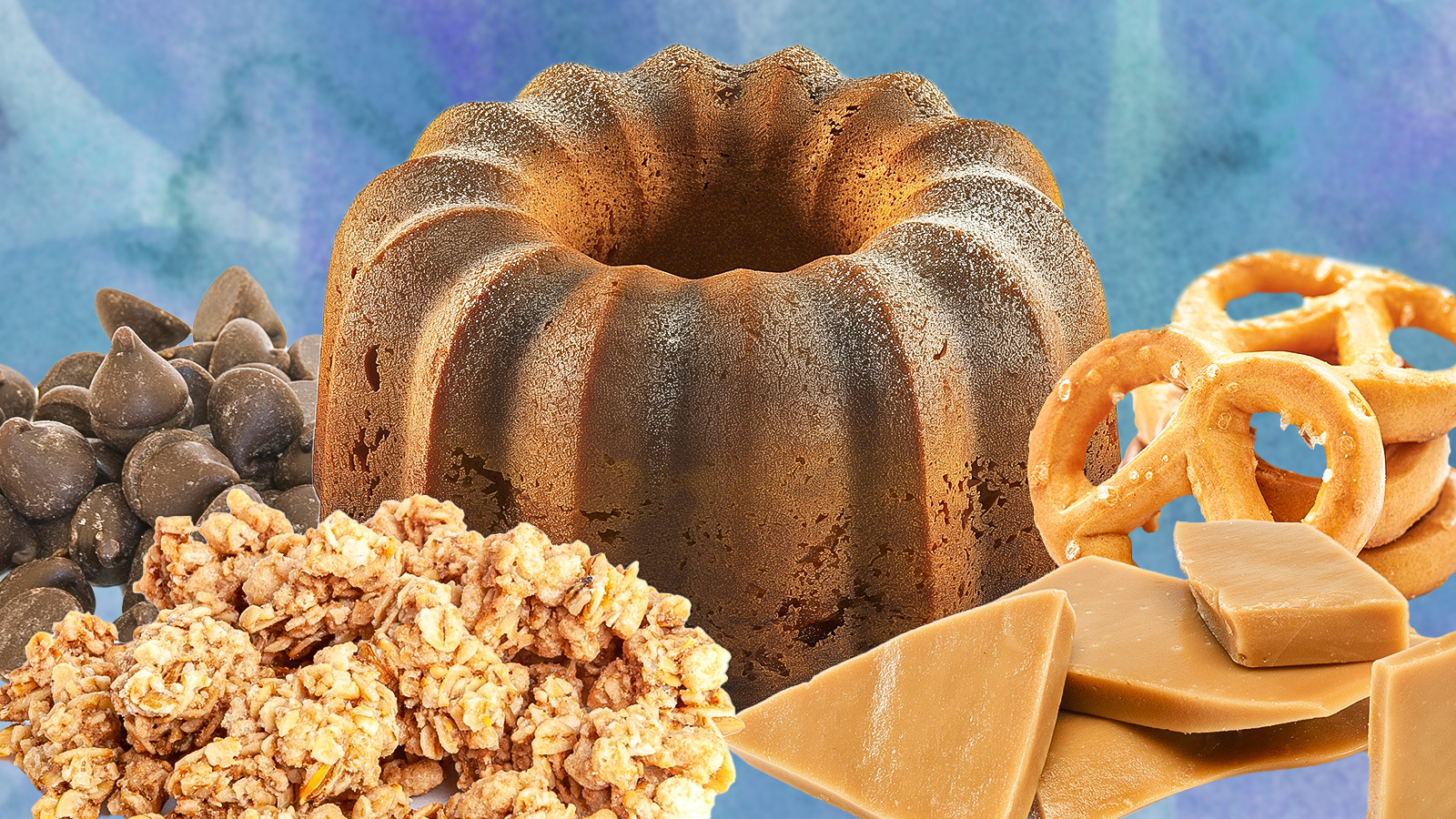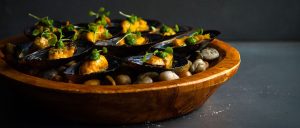There are many words to describe the perfect cake: moist, delicate, sweet, buttery, fluffy, dense, crunchy … err, crunchy? Okay, maybe crunchy isn’t the first thing that one envisions when picturing types of cake, but there is a place for crunchy cakes in this world, especially for those who find the treat to be texturally dull. Cakes are notoriously soft and plush, and we’re not suggesting that you over-bake a cake into oblivion to make it crunchy. Instead, we encourage you to get creative with cake inclusions or toppings to make for a mostly soft cake with a little bit of crunch.
Whether you bake walnut chunks into a cinnamon-spiced cake or adorn your chocolate masterpiece with Oreos, there are plenty of ways to incorporate crunchy elements into a cake. Now, it’s important to note that even the most steadfastly crunchy ingredients might soften up a bit once they’re introduced to a moist cake, especially should you layer them in between a cake or bake them right into the batter. Nevertheless, these ingredients will still add plenty of crunch to your cake, and most of them will also add a distinctly sweet, nutty, warming, or even salty flavor profile all their own, so we consider it a win-win to experiment with crunchy bits in your next cake-baking adventure.
Nuts

It’d be pretty difficult to envision a crunchy baked good and not picture nuts somewhere in the mix, and luckily, various popular types of nuts will work well in your next cake. You could go a classic route and incorporate chopped walnuts into the mix, à la carrot cake, or you could take a bolder approach and toss cashews, pecans, peanuts, or even hazelnuts into your batter. Depending on the nut size, it’d be best to break them down into smaller chunks if you intend to bake them directly into the cake.
If you intend only to use nuts as a garnish, then you can easily keep some or all of the nuts intact for better visual appeal. Whole walnuts would look lovely pressed into swirls of buttercream, whereas whole almonds might add a nice visual contrast atop a white cake (not to mention plenty of crunch). If whole nuts seem a little too jarring, you can sprinkle chopped nuts on top of a decorated cake, or even mix them right into the frosting. Chopped peanuts or sliced almonds would work well mixed into buttercream, adding just the right amount of crunch in each bite without being so hard that you might break a tooth.
Candied nuts
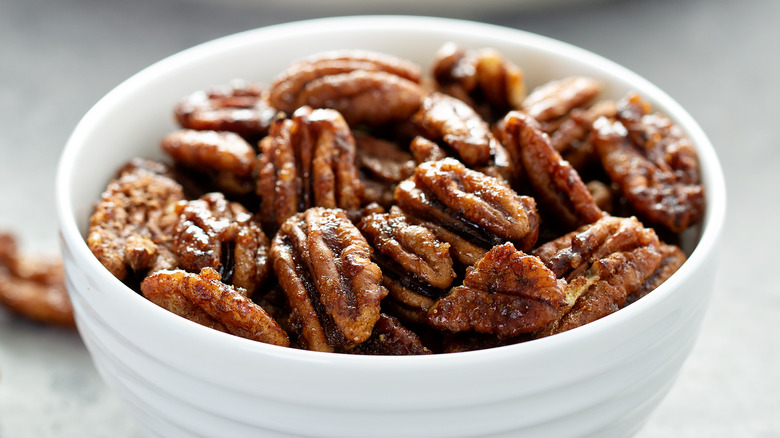
Plain nuts have a lot to offer a cake, including nutty flavor and crunchy texture, but if there’s one thing they won’t contribute to a cake, it’s sweetness. For some people, the lack of sweetness is a perk, seeing as cakes are typically pretty sweet all on their own. However, if you’re looking for a way to add crunchiness, nuttiness, and extra sweetness to a cake, then candied nuts are just the solution.
Perhaps the most obvious choice for a candied nut inclusion would be pecans, seeing as they are already a common cake addition as is. You can’t go wrong with candied pecans, whether you want to add chopped ones to cake batter or whole ones to a decorated cake, but why stop there? Candied walnuts, almonds, or cashews would all work well, as would honey-roasted peanuts. As an added perk, candied nuts would maintain more crunch in your cake thanks to that sugary coating on the outside, which helps protect the nut from the cake’s moisture.
There’s also the opportunity to incorporate spiced flavors into the mix. Whip up a batch of spiced-candied pecans or walnuts to add an extra level of complexity to your cake, and don’t be afraid to get creative — cinnamon, nutmeg, or even pumpkin pie spice would all complement a crunchy candied nut (and, as a result, your cake).
Toffee bits
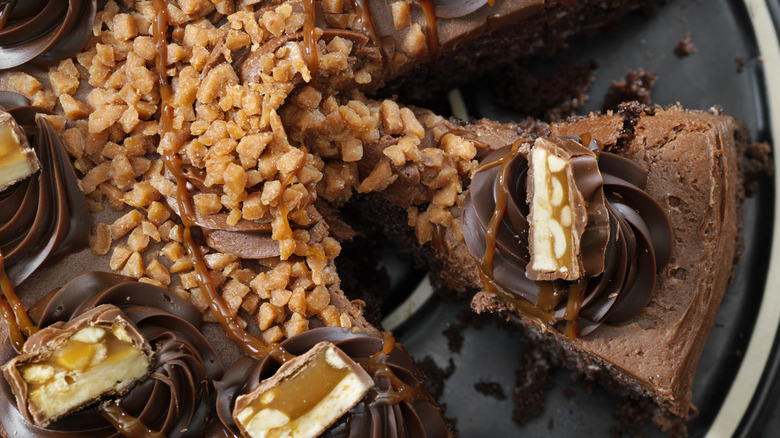
Rich, buttery, and caramel-like, toffee is no stranger to baked goods, seeing as it’s comprised mostly of sugar and butter. There are various types of toffee out there, but the kind that would give your cake the most bang for its buck — at least in terms of crunchiness — would be toffee bits, as opposed to something like toffee chips that you’d find next to the chocolate chips in the baking aisle. You could even make a honeycomb toffee (which requires only four ingredients) if you want to add an extra-crunchy addition to your cake.
To ensure that toffee bits retain their crunch as optimally as possible, these caramelized little bits would work best atop a cake instead of within it. You can go as heavy or as light as you’d like with the toffee bit garnish, sprinkling it on light or absolutely smothering the top of your confection in a toffee layer. If you want to add as much crunch as possible, you might even consider coating the sides of your cake with toffee bits as well — just be sure to add them while the frosting is fresh and wet so that each little crunchy morsel will stick.
Granola
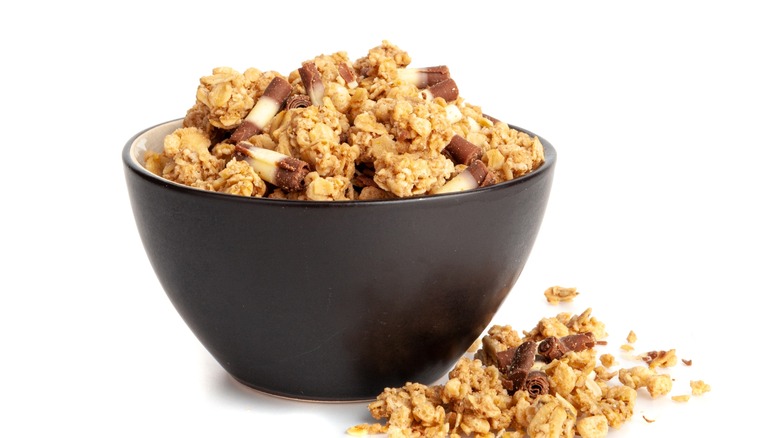
Ermak Oksana/Shutterstock
There are quite a few ways to use granola, be it a more classic route like sprinkling some onto a yogurt parfait or using it to top off a fresh batch of muffins. There’s another opportunity to incorporate granola into the baking realm, which is to add some to your next cake to seriously up the crunchy factor.
Granola — whether store-bought, oat-based, or a homemade version — is very crunchy by nature, thanks to the toasting process that it goes through in the oven. These crunchy little clusters make for great cake inclusions, whether you want to add them directly to the cake batter or sprinkle some on top. If you opt for the baked-into-the-cake route, you may want to break down the clusters a little bit so that there aren’t any overly large bites in the finished product. As for the garnish route, you can opt for a looser granola and lightly sprinkle the top of your cake with it, or you can opt for hefty clusters aptly dotted across the top of your confection.
If you really want to up the crunch factor of your granola, you can also opt for a kind that incorporates nuts, or you customize your own by making it at home. Regardless of what kind of granola you use, you can bet that it will add plenty of crunchy goodness to your moist cake, along with subtle notes of vanilla, honey, cinnamon, or whatever other flavor the granola itself might offer.
Mini chocolate chips
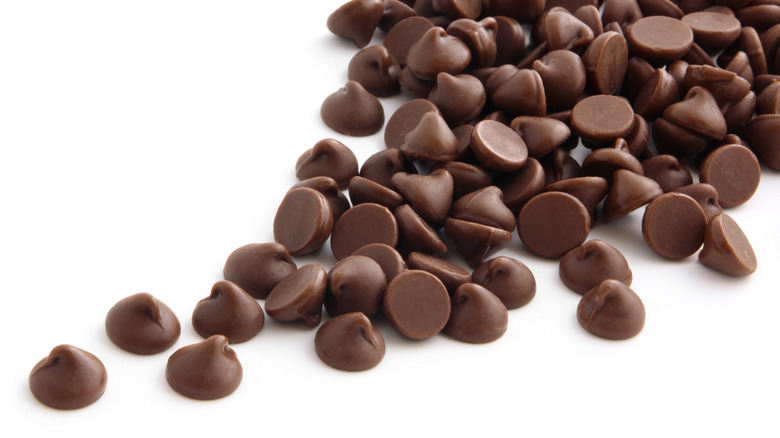
Chocolate is no stranger to the baking world, and one of the most common types of chocolate that you’ll find in a baked good is none other than chocolate chips. While we would never advise against using chocolate chips in a cake, as they pretty much enhance any baked good they grace, we wouldn’t necessarily recommend full-sized chips if you’re looking for crunch in particular. Instead, we’d recommend mini chocolate chips, which pack all of the rich, chocolatey goodness of any kind of chocolate out there, with a crunchy edge.
Anyone who has ever enjoyed a cannoli or ice cream sandwich that’s been rolled in mini chocolate chips knows just how much crunch the tiny morsels can add to a sweet treat. The same concept applies to a cake, though you’d be best off saving the mini chips for a garnish as opposed to baking them into your cake. (It won’t taste bad, but the chips won’t stay crunchy once baked.) Sprinkle mini chocolate chips onto the top of your chocolate cake for an effortless crunchy addition, or coat the sides of your cake à la rolled ice cream sandwich. Get creative with the types of mini chips you use, too — milk, semisweet, dark, and white chocolate are all good options, and you could even experiment with mini yogurt chips, too.
Crushed cereal
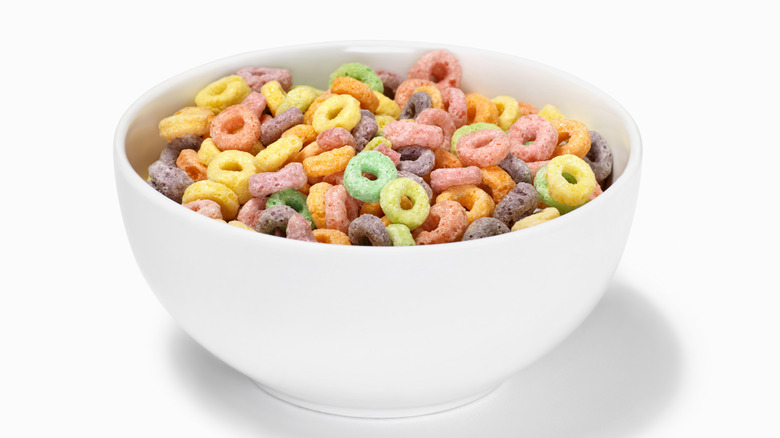
Cereal is good for much more than just a quick and easy breakfast option — in fact, it might just be the key to achieving a perfect crunchy element in your cake. Whether you’re a Froot Loops fanatic or a Cocoa Puffs purist, just about any type of crushed-up cereal will work well in a cake, though some options will taste better than others (i.e., we’d more likely recommend Cinnamon Toast Crunch as opposed to Raisin Bran).
Since there are so many varied breakfast cereals out there, you can really experiment and pick a kind that caters to the flavor of your cake. Chocolatey kinds like Cocoa Puffs or Cookie Crisp would work well in either a chocolate or vanilla cake, whereas something like Fruity Pebbles or Fruit Loops could enhance a strawberry cake. Cinnamon Toast Crunch would naturally work well on top of a cinnamon swirl cake, whereas something more neutral like Frosted Flakes would work as a crunchy factor in just about any cake flavor imaginable.
As for where you should incorporate the cereal, it’s best left as a garnish so that you don’t end up with soggy baked-in bits. You could also add a layer of cereal in between cake layers (on top of a layer of frosting), though keep in mind that this method is best left for those cakes that will be served right away, again to avoid sogginess.
Candy bar bits
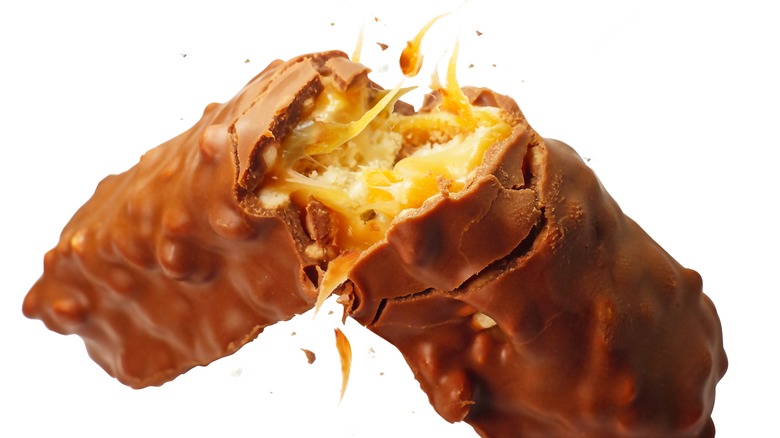
Candy bars essentially offer a two-for-one special in terms of cake additions — not only do they add chocolatey goodness, but certain ones will also offer quite the crunch factor. So, what do we mean by choosing the right one? Well, plain chocolate candy bars like Hershey’s might not be the best option, seeing as the chocolate alone won’t offer a significant amount of crunch on top of a cake. Hershey’s with almonds, however? Now we’re getting somewhere on the crunchy scale.
There are all sorts of candy bars out there, so don’t be afraid to expand your horizons to find that perfect crunchy match. Butterfinger, Crunch (naturally), Snickers, and Twix all include crunchy additions that would in turn help crunch-ify your cake.
Now, we’re not suggesting that you throw a whole candy bar on top of your cake and call it a day, but instead, break the bars apart into smaller (still crunchy) bits. You could also put a layer of crushed-up candy in between your baked cake layers as you’re decorating, but again, make sure that you’ll be serving the cake that same day to retain as much candy crunch as possible.
Crunchy peanut butter
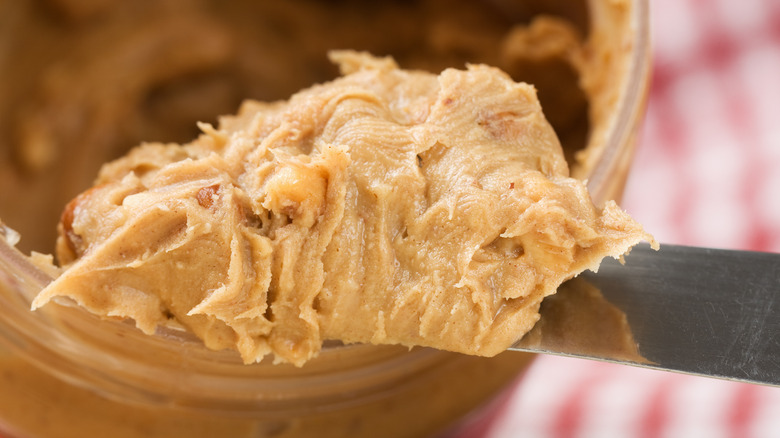
At first thought, peanut butter may not seem like the crunchiest thing out there, or even remotely crunchy at all … unless, of course, you opt for crunchy peanut butter. Laden with big chunks of halved peanuts, crunchy peanut butter would make for an exceptional addition to your next cake, adding both richness from the peanut butter itself and plenty of crunch from the peanut bits.
Among many unconventional ways to use peanut butter, there are a couple of ways you could incorporate it into your cake. First, you could spread some in between layers of baked cake, on top of the frosting to help seal it all in. That way, when you cut out a slice of cake, it’ll have a layer of crunchy, nutty goodness in the middle — something that would work especially well in a chocolate cake, for a Reese’s-esque flavor profile.
You could also swirl peanut butter directly into your cake batter for an effect that is both visually striking and tasty. You don’t want to add too much peanut butter so that the excess oil doesn’t disrupt the way the cake bakes, but a healthy swirl or drizzle will make for an exciting cake addition. And, of course, you’ll also end up with peanuts in the cake if you do it this way, which will ensure a nice crunch throughout.
Pretzels
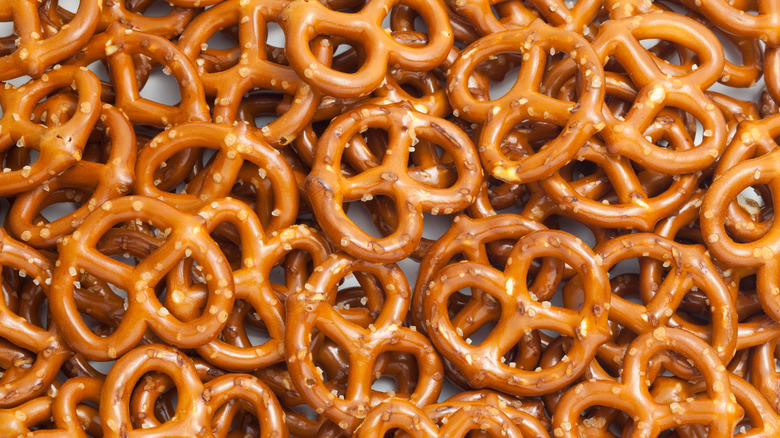
When considering a cake inclusion, be it crunchy or otherwise, it’s pretty easy to conjure images of sweet ingredients and not a whole lot else. It only makes sense to incorporate sweet ingredients into a cake that’s meant to be, well, sweet — but what about salty elements? Other than the small amount of salt that you might add to the cake batter itself or the frosting, saltiness isn’t exactly a flavor profile that most people want in a cake, but little pops here and there can really help create balance in your confection.
Now, if we’re considering ingredients that are both salty and crunchy, pretzels are the obvious go-to. On their own, pretzels may not be the most exciting snack out there, seeing as they have a fairly neutral flavor profile. When it comes to a cake, however, pretzels are a perfect inclusion because of that neutral flavor profile — they’ll add a nice crunch and a hit of saltiness without overshadowing the sweetness of the cake.
Pretzels would work best as a cake garnish, because if you were to bake them into the cake itself, they’d soften up significantly. Luckily there’s a good amount of opportunity to add pretzels right on top of your cake, be they in whole, mini, or stick format. You could even crush up some pretzels in a plastic bag and then sprinkle them on top of your cake for a more evenly distributed crunch.
Crumbled cookies
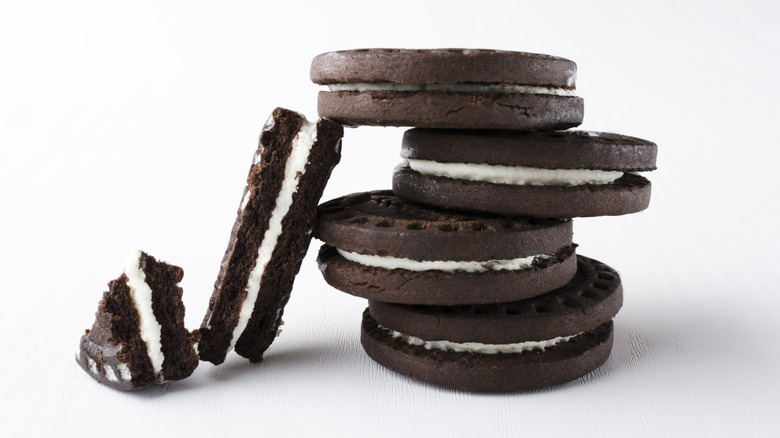
Cookies make for an obvious cake addition, because after all, what baked good isn’t inherently enhanced by another baked good? Of course, in terms of crunchiness, that fresh batch of chewy chocolate chip cookies won’t exactly get the job done. Instead, store-bought cookies like Chips Ahoy!, Oreos, or Nilla Wafers would make for the best inclusions in terms of pure crunchiness.
There are multiple ways you could incorporate cookies into your cake, and using them as a final garnish is the best technique to ensure that they remain as crispy as possible. You can either use intact mini cookies as a garnish, or crumble cookies up and sprinkle them on the top or sides of a frosted cake. You can also layer cookie crumbles in between cake layers, but as expected, the cookie pieces will get a little soggy as the cake sits. They will still retain some of their hardness, so if you’re looking for a softer crunch in your cake, then this method would work well. Otherwise, stick with the garnish route for an optimally crunchy cookie-infused cake.
Freeze-dried berries
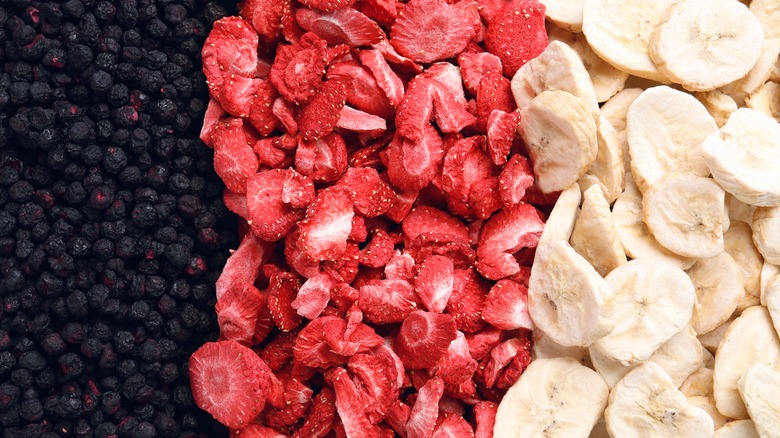
Fruit is certainly no stranger to cakes, but if crunch is what you’re looking for, then you won’t it find in fresh fruit. On the other hand, freeze-dried fruits, particularly berries, will offer that crunch factor while simultaneously adding fruity flavor to your cake and giving it more visual appeal — a baking win-win-win. This is one reason why you should always have freeze-dried fruit in your pantry.
Freeze-dried strawberries are perhaps the most ubiquitous type of freeze-dried fruit out there, and they would also make for a foolproof addition to your strawberry cake. You can bake these crunchy fruits right into your cake or reserve them as a garnish. Raspberries and even bananas would also work well, offering a subtle fruity crunch to just about any flavor of cake out there. You could even experiment and make a freeze-dried fruit streusel if you don’t want to add just the fruit alone.
Rice Krispies Treats
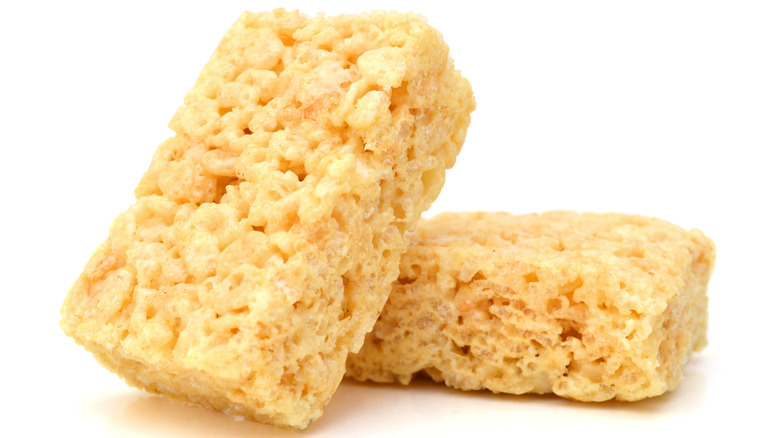
Buttery, sweet, and plenty crunchy, Rice Krispies Treats make for a delightful little snack all on their own — though you could also incorporate them into a cake. The easiest way to add Rice Krispies Treats to your cake would be to buy store-bought ones and cut them into chunks. Then you could arrange those chunks on top of your cake as a final garnish, which wouldn’t necessarily give you the most crunch for your buck, but it would add some crunchy flair.
If you’re looking for a way to more evenly distribute the cereal-based treat in your cake, your best bet is making Rice Krispies Treats yourself, and then shaping a thin layer of them using the same pan you baked your cake layers in. So, if you baked a simple 8-inch round cake, press your homemade Rice Krispies into that pan so that they’ll be the same shape as your cake once cooled. Then, you can take that Rice Krispies circle (or square, or even heart — whatever shape your cake is) and place it right in between two layers of cake. Frost as usual, then voilà — you’ve got a cake with a sweet and crunchy surprise inside.



